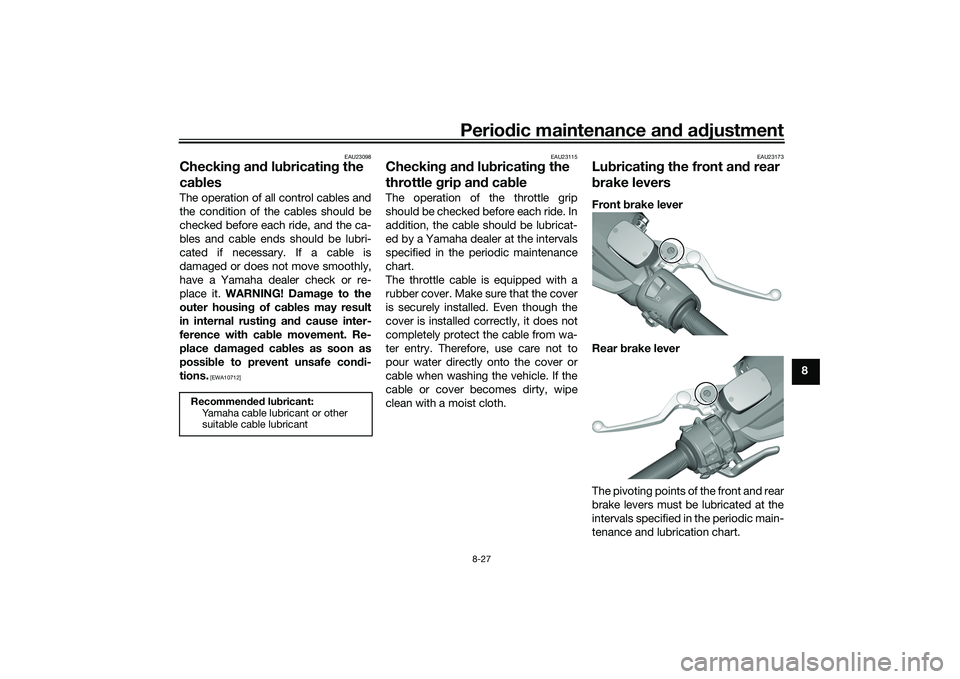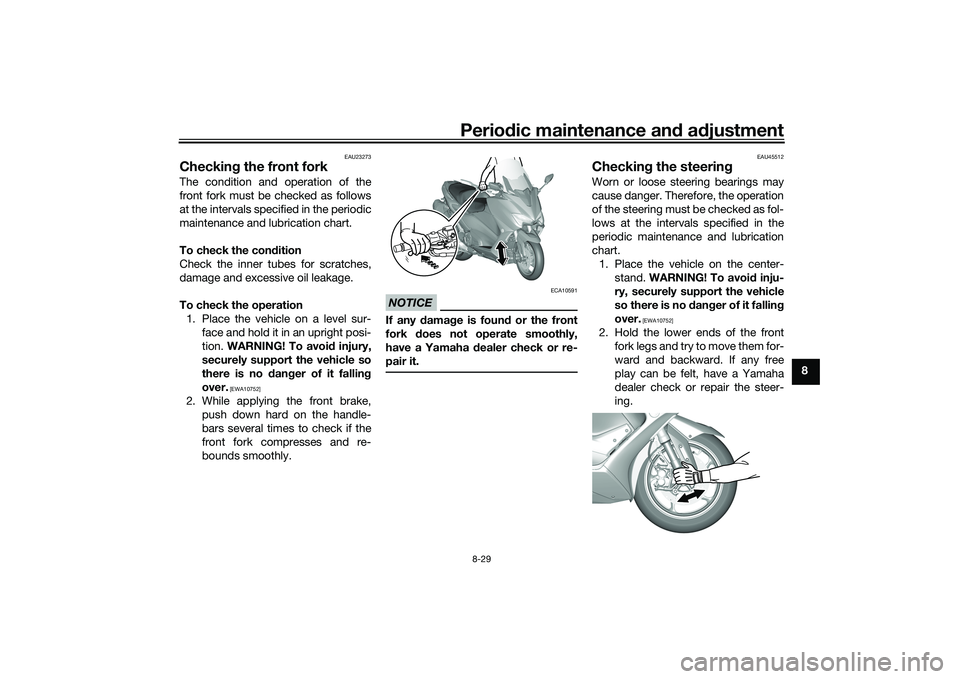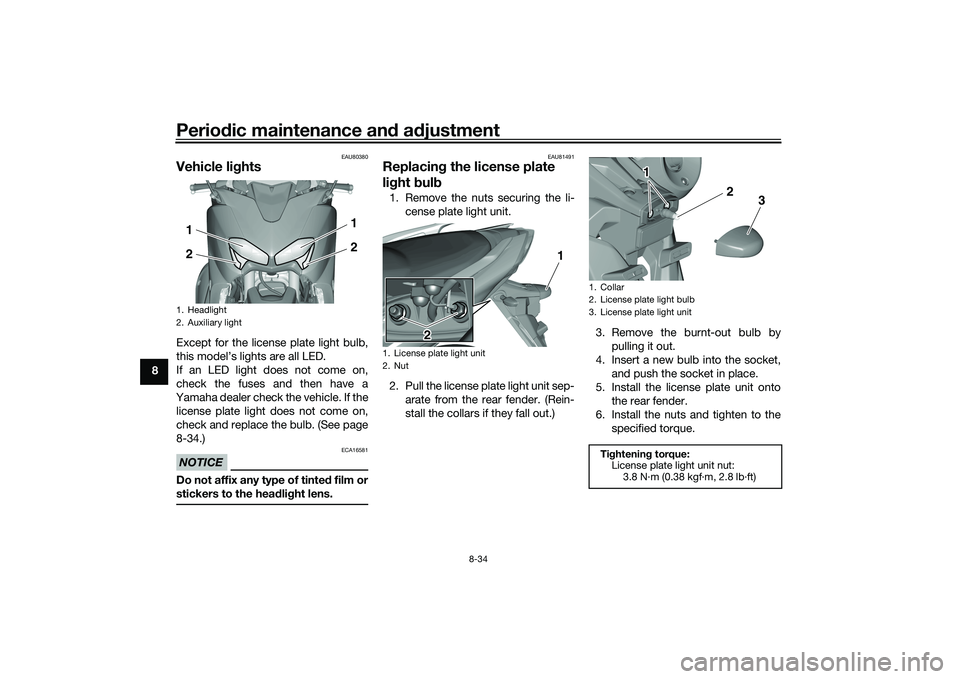YAMAHA TMAX 2020 Owners Manual
Manufacturer: YAMAHA, Model Year: 2020, Model line: TMAX, Model: YAMAHA TMAX 2020Pages: 126, PDF Size: 21.59 MB
Page 101 of 126

Periodic maintenance an d a djustment
8-27
8
EAU23098
Checkin g an d lu bricatin g the
ca blesThe operation of all control cables and
the condition of the cables should be
checked before each ride, and the ca-
bles and cable ends should be lubri-
cated if necessary. If a cable is
damaged or does not move smoothly,
have a Yamaha dealer check or re-
place it. WARNING! Dama ge to the
outer housin g of cab les may result
in internal rustin g an d cause inter-
ference with ca ble movement. Re-
place damag ed cab les as soon as
possi ble to prevent unsafe con di-
tions.
[EWA10712] EAU23115
Checkin
g an d lu bricatin g the
throttle grip an d ca bleThe operation of the throttle grip
should be checked before each ride. In
addition, the cable should be lubricat-
ed by a Yamaha dealer at the intervals
specified in the periodic maintenance
chart.
The throttle cable is equipped with a
rubber cover. Make sure that the cover
is securely installed. Even though the
cover is installed correctly, it does not
completely protect the cable from wa-
ter entry. Therefore, use care not to
pour water directly onto the cover or
cable when washing the vehicle. If the
cable or cover becomes dirty, wipe
clean with a moist cloth.
EAU23173
Lu bricatin g the front an d rear
b rake leversFront brake lever
Rear brake lever
The pivoting points of the front and rear
brake levers must be lubricated at the
intervals specified in the periodic main-
tenance and lubrication chart.
Recommen ded lu bricant:
Yamaha cable lubricant or other
suitable cable lubricant
UB3TE0E0.book Page 27 Tuesday, September 17, 2019 9:35 AM
Page 102 of 126

Periodic maintenance an d a djustment
8-28
8
EAU23215
Checkin g an d lu bricatin g the
centerstan d an d si destan dThe operation of the centerstand and
sidestand should be checked before
each ride, and the pivots and metal-to-
metal contact surfaces should be lubri-
cated if necessary.
WARNING
EWA10742
If the centerstan d or si destan d d oes
not move up an d d own smoothly,
have a Yamaha dealer check or re-
pair it. Otherwise, the centerstan d or
si destan d coul d contact the groun d
an d d istract the operator, resultin g
in a possi ble loss of control.
Recommen ded lu bricant:
Silicone grease
Recommen ded lu bricant:
Lithium-soap-based grease
UB3TE0E0.book Page 28 Tuesday, September 17, 2019 9:35 AM
Page 103 of 126

Periodic maintenance an d a djustment
8-29
8
EAU23273
Checkin g the front forkThe condition and operation of the
front fork must be checked as follows
at the intervals specified in the periodic
maintenance and lubrication chart.
To check the con dition
Check the inner tubes for scratches,
damage and excessive oil leakage.
To check the operation 1. Place the vehicle on a level sur- face and hold it in an upright posi-
tion. WARNING! To avoi d injury,
securely support the vehicle so
there is no dan ger of it fallin g
over.
[EWA10752]
2. While applying the front brake, push down hard on the handle-
bars several times to check if the
front fork compresses and re-
bounds smoothly.
NOTICE
ECA10591
If any damag e is foun d or the front
fork does not operate smoothly,
have a Yamaha d ealer check or re-
pair it.
EAU45512
Checkin g the steerin gWorn or loose steering bearings may
cause danger. Therefore, the operation
of the steering must be checked as fol-
lows at the intervals specified in the
periodic maintenance and lubrication
chart.
1. Place the vehicle on the center- stand. WARNING! To avoi d inju-
ry, securely support the vehicle
so there is no dan ger of it fallin g
over.
[EWA10752]
2. Hold the lower ends of the front fork legs and try to move them for-
ward and backward. If any free
play can be felt, have a Yamaha
dealer check or repair the steer-
ing.
UB3TE0E0.book Page 29 Tuesday, September 17, 2019 9:35 AM
Page 104 of 126

Periodic maintenance an d a djustment
8-30
8
EAU23292
Checkin g the wheel b earingsThe front and rear wheel bearings must
be checked at the intervals specified in
the periodic maintenance and lubrica-
tion chart. If there is play in the wheel
hub or if the wheel does not turn
smoothly, have a Yamaha dealer
check the wheel bearings.
EAU77780
BatteryThe battery is located under panel B.
(See page 8-9.)
This model is equipped with a VRLA
(Valve Regulated Lead Acid) battery.
There is no need to check the electro-
lyte or to add distilled water. However,
the battery lead connections need to
be checked and, if necessary, tight-
ened.
WARNING
EWA10761
Electrolyte is poisonous an d
d an gerous since it contains sul-
furic aci d, which causes severe b
urns. Avoi d any contact with
skin, eyes or clothin g an d al-
ways shiel d your eyes when
workin g near b atteries. In case
of contact, ad minister the fol-
lowin g FIRST AID.
EXTERNAL: Flush with plenty of water.
INTERNAL: Drink lar ge quan-
tities of water or milk an d im-
me diately call a physician.
EYES: Flush with water for 15 minutes an d seek prompt
me dical attention.
Batteries pro duce explosive hy-
d ro gen gas. Therefore, keep
sparks, flames, ci garettes, etc.,
away from the battery an d pro-
vi de sufficient ventilation when
char gin g it in an enclose d
space.
KEEP THIS AND ALL BATTER-
IES OUT OF THE REACH OF
CHILDREN.
To char ge the battery
Have a Yamaha dealer charge the bat-
tery as soon as possible if it seems to
ha v e di s c ha r g e d. Ke e p in m in d t ha t t he
1. Negative battery lead (black)
2. Battery
3. Positive battery lead (red)
1
2
3
UB3TE0E0.book Page 30 Tuesday, September 17, 2019 9:35 AM
Page 105 of 126

Periodic maintenance an d a djustment
8-31
8
battery tends to discharge more quick-
ly if the vehicle is equipped with op-
tional electrical accessories.
NOTICE
ECA16522
To char
ge a VRLA (Valve Re gulate d
Lea d Aci d) battery, a special (con-
stant-volta ge) battery char ger is re-
quire d. Usin g a conventional b attery
char ger will damag e the battery.To store the battery
1. If the vehicle will not be used for more than one month, remove the
battery, fully charge it, and then
place it in a cool, dry place.
NOTICE: When removin g the
b attery, be sure turn the vehicle
power off, then d isconnect the
ne gative lead before discon-
nectin g the positive lea d.
[ECA21900]
2. If the battery will be stored for
more than two months, check it at
least once a month and fully
charge it if necessary. 3. Fully charge the battery before in-
stallation. NOTICE: When install-
in g the battery, connect the
positive lea d b efore connectin g
the ne gative lea d.
[ECA21910]
4. After installation, make sure that
the battery leads are properly con-
nected to the battery terminals.NOTICE
ECA16531
Always keep the b attery charged .
Storin g a dischar ged battery can
cause permanent b attery damag e.
EAU81472
Replacin g the fusesFuse box1, brake light fuse and cruise
control fuse are located behind panel
A. (See page 8-9.)
Fuse box 2 and main fuse are located
behind the windshield.1. Fuse box 1
2. ABS control unit fuse
3. Auxiliary DC jack fuse
4. Headlight fuse
5. Electronic throttle valve fuse
6. ABS motor fuse
7. ABS solenoid fuse
8. Spare fuse
9. Cruise control fuse (XP560D)
10.Brake light fuse (XP560D)2
3
4
5
6
7
8
8
9
10
1 1
UB3TE0E0.book Page 31 Tuesday, September 17, 2019 9:35 AM
Page 106 of 126

Periodic maintenance an d a djustment
8-32
8
TIPTo access the main fuse, remove the
starter relay cover.To access fuse box 2 and the main
fuse, proceed as follows. 1. Remove the screw access covers
by removing the quick fasteners.
2. Remove the caps.
3. Remove the windshield by remov- ing the screws. 4. Remove the inner panel by remov-
ing the bolts and quick fasteners.
5. Install the inner panel by installing the bolts and quick fasteners.1. Starter relay cover
2. Main fuse
3. Spare main fuse
4. Fuse box 2
5. Signaling system fuse
6. Ignition fuse
7. Taillight fuse
8. Radiator fan motor fuse
9. Fuel injection system fuse
10.Backup fuse
11.Spare fuse
12.Spare fuse (XP560D)
13.Windshield motor fuse (XP560D)
14.Baggage fuse (XP560E)
5
6
7
8
9
10
12 13,14 11
1 1
2
3
2
3
4
4
1. Screw access cover
2. Quick fastener
1. Cap
1
212
1
1. Windshield
2. Screw
1. Inner panel
2. Bolt
3. Quick fastener
12
2 21 2
2
3 3
2
UB3TE0E0.book Page 32 Tuesday, September 17, 2019 9:35 AM
Page 107 of 126

Periodic maintenance an d a djustment
8-33
8
6. Install the windshield by installing
the screws.
7. Install the caps.
8. Install the screw access covers by installing the quick fasteners.
If a fuse is blown, replace it as follows. 1. Turn the vehicle power off.
2. Remove the blown fuse, and then install a new fuse of the specified
amperage. WARNING! Do not
use a fuse of a hi gher ampera ge
ratin g than recommen ded to
avoi d causin g extensive dam-
a g e to the electrical system an d
possi bly a fire.
[EWA15132]
3. Turn the vehicle power on and turn
on the electrical circuit in question
to check if the device operates.
4. If the fuse immediately blows again, have a Yamaha dealer
check the electrical system.
1. Screw access cover
1
Specified fuses:
Main fuse:
40.0 A
Headlight fuse: 7.5 A
Taillight fuse: 7.5 A
Signaling system fuse:
7.5 A
Ignition fuse: 7.5 A
Radiator fan motor fuse: 15.0 A
Fuel injection system fuse:
7.5 A
ABS control unit fuse: 7.5 A
ABS motor fuse: 30.0 A
ABS solenoid fuse:
15.0 A
Auxiliary DC jack fuse: 2.0 A
Backup fuse: 15.0 A
Electronic throttle valve fuse:
7.5 A
Baggage fuse: 7.5 A (XP560E)
Brake light fuse: 1.0 A (XP560D)
Cruise control fuse:
1.0 A (XP560D)
Windshield motor fuse: 20.0 A (XP560D)
UB3TE0E0.book Page 33 Tuesday, September 17, 2019 9:35 AM
Page 108 of 126

Periodic maintenance an d a djustment
8-34
8
EAU80380
Vehicle li ghtsExcept for the license plate light bulb,
this model’s lights are all LED.
If an LED light does not come on,
check the fuses and then have a
Yamaha dealer check the vehicle. If the license plate light does not come on,
check and replace the bulb. (See page
8-34.)NOTICE
ECA16581
Do not affix any type of tinted film or
stickers to the head light lens.
EAU81491
Replacin g the license plate
li g ht bul b1. Remove the nuts securing the li-
cense plate light unit.
2. Pull the license plate light unit sep- arate from the rear fender. (Rein-
stall the collars if they fall out.) 3. Remove the burnt-out bulb by
pulling it out.
4. Insert a new bulb into the socket, and push the socket in place.
5. Install the license plate unit onto the rear fender.
6. Install the nuts and tighten to the specified torque.
1. Headlight
2. Auxiliary light2 1
2
1
1. License plate light unit
2. Nut
21
1. Collar
2. License plate light bulb
3. License plate light unitTi
ghtenin g torque:
License plate light unit nut:
3.8 N·m (0.38 kgf·m, 2.8 lb·ft)
3
2
1
UB3TE0E0.book Page 34 Tuesday, September 17, 2019 9:35 AM
Page 109 of 126

Periodic maintenance an d a djustment
8-35
8
EAU25865
Trou bleshootin gAlthough your Yamaha received a thor-
ough inspection before shipment from
the factory, trouble may occur during
operation. Any problem in the fuel,
compression, or ignition systems, for
example, can cause poor starting and
loss of power.
The following troubleshooting chart
represents a quick and easy procedure
for checking these vital systems your-
self. However, should your vehicle re-
quire any repair, take it to an
authorized Yamaha dealer whose
skilled technicians have the necessary
tools, experience, and know-how to
properly service your Yamaha vehicle.
Be sure to use only genuine Yamaha
replacement parts. Although imitation
parts may look similar to genuine parts,
they are often inferior in quality, have a
shorter service life, and can lead to an
expensive repair bill later on.
WARNING
EWA15142
When checkin g the fuel system, d o
not smoke, an d make sure there are
no open flames or sparks in the ar- ea, inclu
din g pilot li ghts from water
heaters or furnaces. Gasoline or
g asoline vapors can i gnite or ex-
plo de, causin g severe injury or prop-
erty damag e.
EAU77992
Smart key system trou bleshootin g
Please check the following items when
the smart key system does not work. Is the smart key turned on? (See
page 3-5.)
Is the smart key battery dis-
charged? (See page 3-6.)
Is the smart key battery installed
correctly? (See page 3-6.)
Is the smart key being used in a lo-
cation with strong radio waves or
other electromagnetic noise? (See
page 3-1.)
Are you using the smart key that is
registered to the vehicle?
Is the vehicle battery discharged?
When the vehicle battery is dis-
charged, the smart key system will
not operate. Please have the vehi-
cle battery charged or replaced.
(See page 8-30.) If the smart key system does not work
after checking the above items, have a
Yamaha dealer check the smart key
system.
TIPSee Emergency mode on page 8-38
for information on starting the engine
without the smart key.
UB3TE0E0.book Page 35 Tuesday, September 17, 2019 9:35 AM
Page 110 of 126

Periodic maintenance an d a djustment
8-36
8
EAU86350
Trou bleshootin g chart
Check the fuel level in
the fuel tank.1. Fuel
There is enough fuel.
There is no fuel.
Check the battery.
Supply fuel.
The engine does not start.
Check the battery.
Try starting the engine.4. Compression
There is compression.
There is no compression.
The engine does not start.
Have a Yamaha dealer check the vehicle.Have a Yamaha dealer check the vehicle.
Remove the spark plug
and check the electrodes.3. Ignition
Wipe off with a dry cloth and correct the
spark plug gap, or replace the spark plug(s). Have a Yamaha dealer check the vehicle.
The engine does not start.
Check the compression.
Operate the electric starter.2. Battery
The engine turns over
quickly.
The engine turns over
slowly.
The battery is good.
DryWet
Try starting the engine.
Check the battery lead connections,
and charge the battery if necessary.
The engine does not start.
Check the ignition.
UB3TE0E0.book Page 36 Tuesday, September 17, 2019 9:35 AM